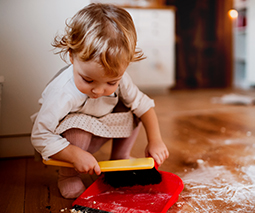The unexpected joy of watching your child learn to read

Watching my oldest son’s tiny shoulders balance his huge new bag and walk into big school for the first time this year, I prepared myself to say goodbye to all the firsts.
His first words, first steps, first foods had all led us this point – and gratefully so – we had a healthy, happy, well-adjusted kid who was eager to start his next phase of life.
But as I’ve come to understand during our big school journey, the new-parent in you (the one that was handed that bundled of joy moments after birth) is never far away.
And that has never been truer for me than just a few weeks ago when my son started to read.
The process for us has been what I would describe as average.
Slow and steady
He’s been in kindergarten for six months now, and while always keen to read a book with me, his words have emerged at their own pace.
The first few months of readers were mostly about the pictures. While he pointed to the words with his little finger, it was the pictures he’d glance at for confirmation.
According to his teacher, this was normal behaviour – and while we’d sometimes cover the images, his teacher assured us this is part of the journey.
“Everyone gets to reading in their own time,” she said.
The next phase was using his memory – he’s always had a good one. Because he’d bring the same book home a couple of times a week, he got used to the rhythm and pattern of the words in a sequence.
A few weeks ago, I decided to go into his class and help with reading. Sitting with each of his 15 class buddies gave me some good perspective: almost half were at the same level he was at. And of course, there were two girls and one boy who were miles ahead of the rest. But it was interesting to see they all had their own ways of learning and reading style.
It was time
Then, seemingly out of nowhere, his teacher’s words rang true: his reading time had come.
“I got a level 3, mum!” he told me one afternoon as he pulled a book from his bag.
He confidently recognised words that the previous week had been too hard. Words like ‘concert’ and ‘farmer’ were being read naturally, no prodding or sighing or frustration. I felt a sense of overwhelming pride and delight. As someone who’s always loved reading, I have been in awe of the process of learning to read. It’s as remarkable to me as the day his chubby legs decided to walk.
Not always so straightforward
Sharing this story with mum friends the other day, I realised the reading journey is a personal one and not always so straightforward.
Jess, a mum of three, said it took longer than expected for her son to read: “It took Charlie a while to learn to read and I thought it would never happen. He went through reading recovery and it made a huge difference… I have a photo of him on top of a statue which had a sign saying ‘DO NOT CLIMB’ and he was so proud to be able to read it.”
Sally, a mum of two said, “It’s not happening for my kid and it’s heartbreaking. Teachers are baffled. She tries but made very little progress – whatever it is it just hasn’t clicked yet and it’s worrying.”
As for mum-of-two Kylie, she said, “Sam has been struggling with reading over the past couple of years, but with the support of his teachers and a reading recovery program and daily practise I swear he’s come leaps and bounds! I went into his room the other night to say goodnight and found him with a book in hand. I cried with happiness!”
Donne, a mum of one, just had a proud-mum-reading moment. “Hendrix sat down and read me Green Eggs and Ham over breakfast last week and it was the single greatest moment of my life,” she said.
How to nurture the process
Paulette Pocock is a Sydney kindergarten teacher and she says reading is a process that needs to be nurtured.
“I have worked with many kindy kids who really struggle to build reading skills and it can be heartbreaking for the kids who find it a gruelling process when it’s easy for others,” she said, sharing three tips for parents to help their children learn to read.
1. Just keep plugging away. Make sure you still read to your child from books you love – it’s important not to lose a love of reading while you’re learning to read independently. Some kids need to practise a skill over 50 times, many of us give up after just 10.
2. Use as many clues as you can, not just sounds. For example, look at the shape of the word, does it look like another word? How does your mouth feel when you say the word? Can you see another word inside that word?
3. Tracing activities. Make letter shapes with playdough; trace letters on the wall with a torch; or use pipe cleaners or fingers to make letters in sand, like this fun Montessori-inspired alphabet activity.













